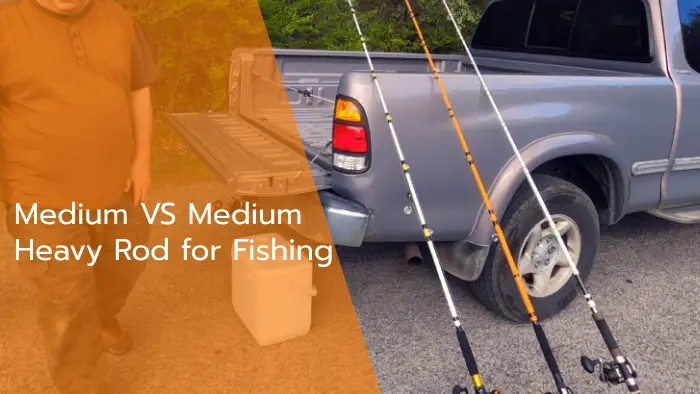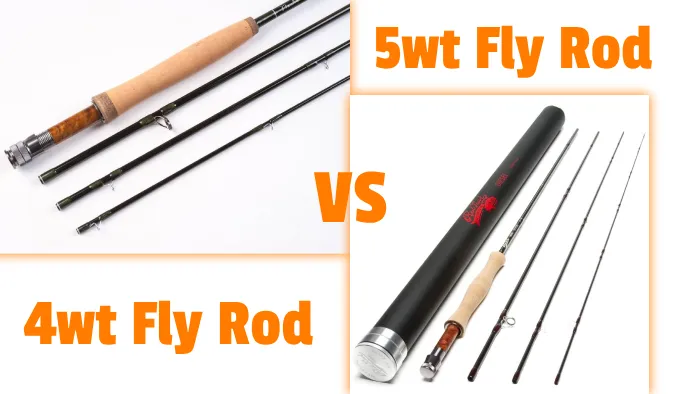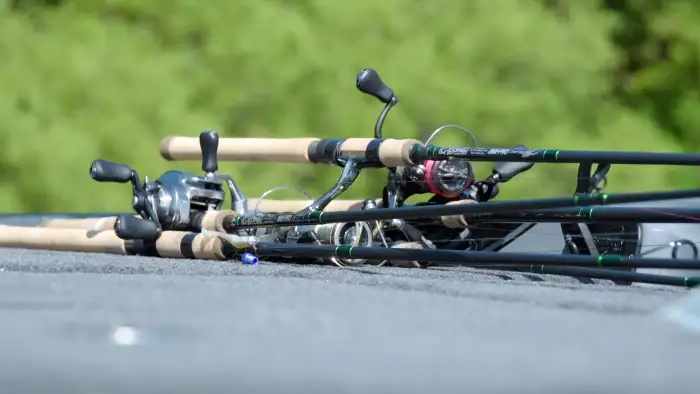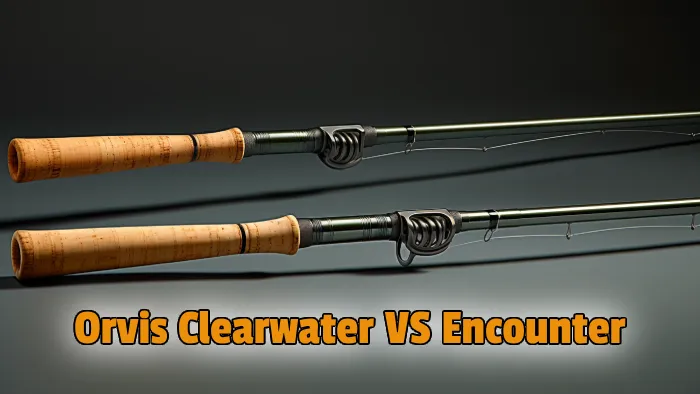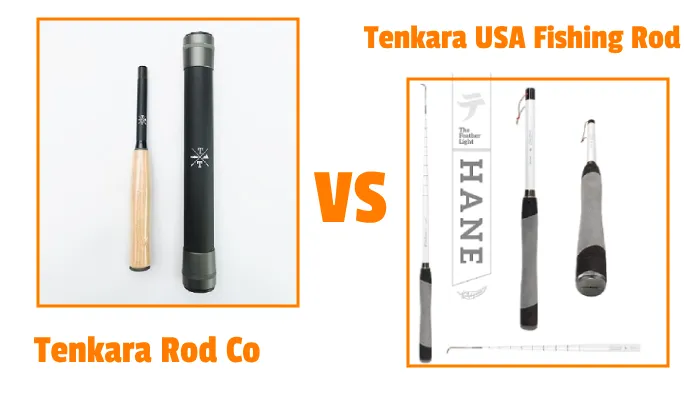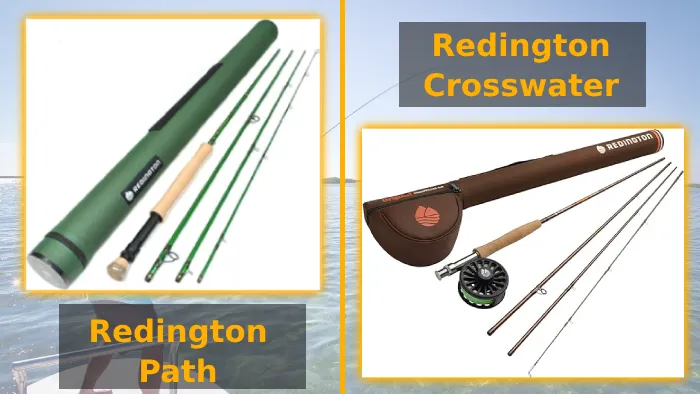Medium vs Medium Heavy Rod for Fishing: The 7 Most Important Differences
Fishing success can be dependent on the type of fishing rod you use. The two most common types are medium and medium-heavy rods, each with strengths and weaknesses. Knowing the difference between them and when to use each can mean the difference between a successful day of fishing or going home empty-handed.
A medium rod is designed to have moderate power, while a medium-heavy rod has more power and less flexibility. Also, medium fishing rods flex more, allowing for better casting performance. However, medium-heavy rods are less flexible, making them less suitable for extended casting with lighter lures.
Throughout this in-depth article, we will discuss the differences between the medium & medium heavy rods and what each one offers. So, let’s explore everything you need to know about these rods for your next fishing trip.
Differences Between Medium and Medium Heavy Rods for Fishing
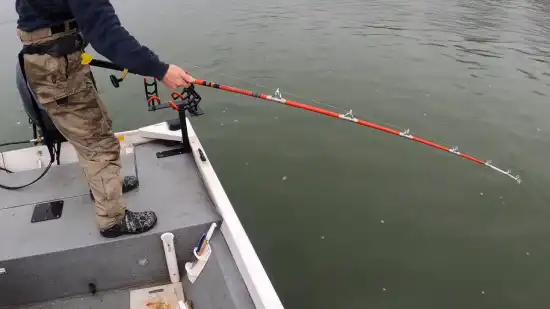
When choosing between a medium and medium heavy rod for fishing, there are a couple of things to consider. These include:
- Power & strength rating
- Lure weight compatibility
- Casting performance and accuracy
- Hooksett strength
- Sensitivity
- Fighting fish
- Fish size
We’ll go over these differences in more in-depth:
1. Power & Strength Rating
The power and strength ratings of a medium rod and a medium heavy rod differ because they’re flexible and bend differently.
A medium rod is designed with moderate power, allowing it to bend relatively easily when applying pressure. This makes it suitable for handling lighter lures and smaller fish.
Conversely, a medium-heavy fishing rod has more strength and less flexibility. It requires more force to bend, making it better equipped for handling heavier lures and larger, more aggressive fish.
2. Lure Weight Compatibility
Lure weight compatibility differs between medium and medium-heavy rods due to their varying levels of flexibility and force required to bend.
A medium rod is suitable for lures ranging from 1/4 ounce to 1/2 ounce, perfect for lighter lures and finesse techniques. With its versatility, it can handle a variety of lure presentations, including topwater, drop shot, and soft plastics.
Alternatively, a medium-heavy rod is designed for lures weighing over 1/4 of an ounce, providing the casting power needed for heavier lures like crankbaits or jigs. It offers quicker and more forceful lure movements, making it ideal for techniques like ‘popping’ topwater lures.
3. Casting Performance and Accuracy
Consider your chosen rod’s flex and casting distance to improve your casting performance and accuracy.
A medium rod is a great option to achieve longer casts and load up the rod for powerful throws. Its flexibility allows for better casting performance and control, making it ideal for casting lighter baits with good accuracy. You can confidently cast lures as light as 1/16 ounce with a medium rod.
In contrast, a medium-heavy rod is less flexible and more suited for shorter, controlled casts. It may not be the best choice for long-distance casting with lighter lures, as it sacrifices finesse and accuracy in those situations. However, it can cast heavier baits with greater distance.
4. Hooksett Strength
If you want a stronger hookset, consider using a medium-heavy rod for techniques that require more force. A medium-heavy rod is designed to provide the extra power needed to drive the hooks into the fish’s mouth, especially when fishing in heavy cover or targeting species with tough mouths.
However, medium rods are ideal for lures with exposed or treble hooks. They provide a forgiving bend, ensuring the line tightens into a fish’s mouth without excessive force, reducing the risk of losing the fish.
Medium rods are well-suited for techniques that require a steady and controlled hookset, such as fishing with treble hooks or techniques where a forceful hookset may damage the fish.
5. Sensitivity
Sensitivity is an important factor to consider when choosing a fishing rod. A medium rod may be your best bet if you’re a professional angler looking to feel every subtle movement and bite. With more flexibility, these rods offer heightened sensitivity that can make all the difference in catching fish.
On the other hand, if you’re looking for a stronger, stiffer rod, a medium-heavy option might be more suitable. Remember that the sacrifice for strength and stiffness is often sensitivity.
6. Fighting Fish
Medium fishing rods maintain tension and provide flexibility that can make your fishing experience all the more exciting. With a medium rod, you can expect to use a lighter line while still being able to play your fish with ease.
Meanwhile, a medium-heavy rod requires a heavier line and a higher gear ratio reel but can quickly reel in fish due to its reduced flex. Choosing the rod that works best for you and your target fish is important regardless of your preference.
7. Fish Size
Professional anglers suggest using a medium-power rod for fishing bass, which perfectly balances flexibility and strength. This keeps the fish from slipping away while allowing for a good fight.
However, a medium-heavy rod may be better if you’re targeting larger and more powerful fish like pike, walleye, or muskies. These rods bring extra strength, ensuring you can pull in the big ones.
Comparison Table Between Medium vs Medium Heavy Rod
| Aspect | Medium Rod | Medium-Heavy Rod |
| Power and Strength Rating | Moderate power, more flexibility | Greater strength, less flexibility |
| Lure Weight Compatibility | 1/4 ounce to 1/2 ounce | Over 1/4 ounce |
| Casting Performance | Longer casts, better control | Shorter, controlled casts |
| Hookset Strength | Ideal for lures with exposed hooks | Extra power for driving hooks |
| Sensitivity | Heightened sensitivity | Sacrifice sensitivity for strength |
| Fighting Fish | Lighter line, playful experience | Heavier line, quick reeling |
| Fish Size | Suitable for bass fishing | Better for larger and more powerful fish |
Is there any big difference between medium and medium-heavy rods?

There isn’t a significant difference between medium and medium-heavy rods, but the latter can handle larger lures and more cover. Both rods are designed to balance sensitivity and power, making them suitable for various fishing situations, such as fly fishing in Pennsylvania, Texas, or any other location.
The medium rod is ideal for lighter lures and fishing in open water with fewer weeds and grass. It offers great flexibility and sensitivity, allowing you to detect subtle bites.
Conversely, the medium-heavy rod is better suited for fishing in water with more cover, such as thick weeds or debris. It provides the extra strength and backbone needed to easily pull larger lures through these obstacles, increasing your chances of landing a catch.
What is a medium-heavy rod good for?
A medium-heavy fishing rod is perfect for fishing with heavier jigs, lures, rigs, and soft plastics. This rod type is designed to handle lures weighing between 1/4 to 1 ½ oz, making it ideal for targeting larger fish or fishing in heavy cover.
The medium-heavy rod provides the necessary load for casting long distances, allowing you to reach those hard-to-reach spots. Also, it offers enough sensitivity to detect even the slightest bites, ensuring you don’t miss any opportunities.
What size fish can a medium-heavy rod handle?
You’ll be able to handle larger fish, as a medium-heavy spinning rod can handle fish of various sizes. The medium-heavy rod has a stronger backbone, allowing more power and control when fighting bigger fish.
This rod type is commonly used for bass fishing, including largemouth, smallmouth, and striped bass. It can also handle other types of bass, such as sand, Guadalupe, and more. The medium-heavy rod is designed to handle the weight and strength of these fish without compromising its performance.
What is a 7ft medium heavy rod used for?
A 7ft medium heavy rod is a versatile tool that can handle various fishing techniques. With this rod, you can effectively fish with Texas rigs, smaller jigs, spinnerbaits, vibrating jigs, topwater lures, and crankbaits, among other types of baits.
The rod’s medium-heavy power provides the backbone and strength to handle larger fish and heavier lures while maintaining good sensitivity to detect subtle strikes.
Is a medium rod good for beginners?
When starting as a beginner, it’s great to consider a versatile fishing tool like a medium rod. This rod type balances strength and sensitivity, making it suitable for various fishing techniques.
The medium rod is particularly useful for beginners because it offers enough power to handle larger fish while allowing for a decent amount of sensitivity to detect bites and subtle movements. It’s a great choice for fishing with various lure types, such as jigs, crankbaits, and spinnerbaits.
Is a medium-heavy rod good for inshore fishing?
A medium to medium-heavy rod offers great strength and sensitivity for inshore fishing. This rod type is designed to handle larger fish and heavier tackle, making it ideal for targeting species commonly found in inshore waters, such as redfish, snook, and speckled trout.
The medium-heavy power allows you to easily cast heavier lures and bait while providing the sensitivity to detect subtle strikes. Also, the extra strength of a medium-heavy rod allows you to fight and land larger fish without fear of the rod breaking.
Medium or Medium Heavy Rod: Choose Properly for Your Fishing Experience
You should consider certain factors when choosing a medium or medium heavy rod for fishing. Despite their strengths, medium and medium-heavy rods have unique benefits that can help you catch more fish.
Medium rods are great for lighter lures and smaller fish, while medium heavy rods are best for heavier lures and bigger, more aggressive fish. So, before your next fishing trip, think about what you’ll be fishing for and which rod will suit your needs the best.With the right technique and experience, a versatile option can help you land even the biggest catches and make your inshore fishing adventures successful and rewarding.

